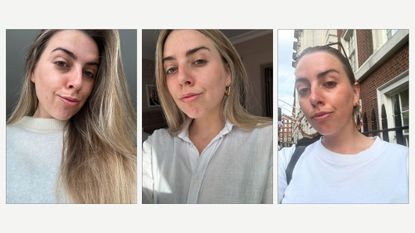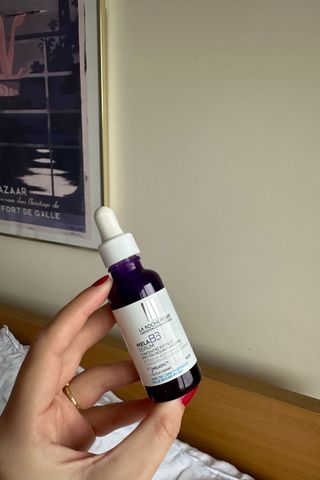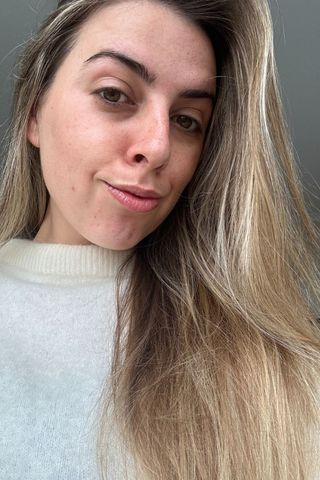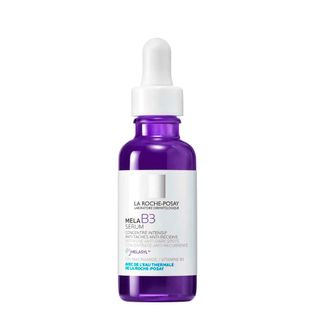I've used this French pharmacy serum for 7 months to treat post-acne marks—here's proof it *actually* works
It's really good at what it does


I have a tumultuous relationship with face serums—but La Roche-Posay Mela B3 serum has, truthfully, stunned me. You see, my skin is oily, prone to acne and lives in a permanently congested state. On top of this, it is also very reactive and susceptible to hyperpigmentation. And, let me tell you, finding a treatment serum that deals with the above issues all at once is very difficult.
More often than not, retinol serums leave my face dry, serums that contain exfoliating acids turn me a neon shade of red and vitamin C serums can leave me with irritation-induced bumps and breakouts. As a result, over the past few years I have found my happy place in a simple skincare routine that leaves hardworking serums out entirely. But more recently the acne-induced dark spots have been causing me increasing distress. As soon as I'm over the pain and turmoil of a breakout, I'm left with dark spots that take months (sometimes years) to fade—and I know that a serum is the most effective skincare product to help me in this situation. So, when I was introduced to La Roche-Posay's new serum at the start of the year, my interest was piqued. Now, after eight months of using it every single day, I have some very important insights.

Ask any dermatologist or beauty editor and they will tell you that La Roche-Posay is up there with the best skincare brands in existence. The French beauty brand has spent decades formulating the best, science-led products to tackle some of the skin's most common issues—and they're good at it. In fact, some of the most ground-breaking dermatological insights and discoveries within skincare have been made with La Roche-Posay's involvement (under the research of its parent company, L'Oréal). So, when I first heard that La Roche-Posay had some big news to share around a groundbreaking new serum, I was obviously intrigued.
And then, when I found out what the new serum was, suffice it to say the brand had every bit of my attention—Mela B3 is an anti-hyperpigmentation serum that tackles dark spots in a way that no other skincare product has done before. And, believe me, I wouldn't be writing this if I hadn't experienced its game-changing abilities for myself.
What does La Roche-Posay Mela B3 serum do?
In essence, Mela B3 promises to tackle even the most persistent dark spots to leave a more even, glowing, healthier-looking complexion. How does it work? It champions the latest skincare breakthrough as its hero ingredient. This discovery comes in the form of Melasyl—a multi-patented molecule that has been 18 years in the making within L'Oréal's research & innovation teams.
Mela B3 serum was the first product to contain Melasyl in L'Oréal's vast portfolio. Without boring you with the nitty-gritty science (seriously, the process of how and why hyperpigmentation occurs is long and requires textbooks), I'll give you the top line. Essentially, while anti-hyperpigmentation ingredients of yesteryear target the effect of hyperpigmentation, Melasyl works by intercepting the production of excess melanin before it reaches the stage of showing on the skin—all without affecting the skin's natural melanin levels (meaning it can be used on all skin tones).
Along with Melasyl, Mela B3 also contains 10% niacinamide (my favourite skincare ingredient) to further reduce the appearance of dark spots, while also reducing the appearance of large pores and supporting that all-important skin barrier.
Marie Claire Newsletter
Celebrity news, beauty, fashion advice, and fascinating features, delivered straight to your inbox!
The cherry on top? Retinyl plamitate (a form of retinol) along with lipo-hydroxy acid (LHA) work to boost cell renewal for a more glowing, fresher-faced complexion. Oh, and there's a hearty dose of plumping hydration in there too, in the form of hyaluronic acid.
The result is substantially more even and glowing skin. In fact, the clinical studies showed that on the 50 subjects tested, 94% had a clinical reduction in dark spots after 12 weeks of testing.
My honest review
After 2 months of use

Truthfully, it's not often I share an image of my totally make-up-less face on the internet—especially in recent months. A particularly bad bout of acne has left the lower third of my face covered in dark spots and scars. If you're thinking things don't look that bad in the above picture, it's because I have been using Mela B3.
A go-to for dermatology wisdom amongst beauty editors, psychodermatologist Dr Alia Ahmed says, "Hyperpigmentation can have emotional as well as physical impacts. People with hyperpigmentation report impact on quality of life, which has largely been ignored." And this is an insight that really resonates with me. While my acne no doubt has a dramatic impact on my quality of life (the last breakout had me not wanting to leave the house and, when I had to, I wrapped a scarf around my face), the dark spots it leaves behind can be equally as upsetting.
So, figuring I had little to lose, I decided to incorporate a serum into my skincare routine for the first time in many, many months. I started by applying Mela B3 morning and night (ensuring I follow up with SPF in the morning due to the retinol component), and even after the first couple of weeks of use I started to notice a dramatic reduction in the appearance of my dark spots. I have a particularly persistent dark spot on my chin following a cystic outbreak two months ago (which has also left an ice-pick scar—joy), and while it showed no signs of subsiding, a few weeks of Mela B3 use had it looking a whole lot better.
During that time, I didn't notice even a hint of irritation from using the serum—my skin is lapping it up. I simply apply it straight after cleansing and follow up with my usual moisturiser or facial sunscreen.
After 7 months of use

After three or four months of use, however, the weather started to change and my skin became drier and more susceptible to irritation. It was around this time I noticed that the skin around my mouth, in particular, was prone to redness and flaking. Luckily, my insight told me this was probably a reaction to the retinyl, so I stripped back my MelaB3 application to nighttime-only use.
For the past three months or so, I have been using Mela B3 serum every single night, and the impact it has made on my breakouts and scarring as been extraordinary. I'm experiencing fewer breakouts, for starters, and when I do get a hormonal spot, it clears up much quicker than it typically would, with less fuss. And as for the post-breakout marks? Well, they barely stick around for longer than a week or two. Truthfully, my skin hasn't looked this good in years.
For a La Roche-Posay serum, I will admit the price is steep. In fact, at £48 it's one of the most expensive products the brand offers, so that's something to consider, particularly if dark spots aren't currently proving a concern for you. However, if you do struggle with hyperpigmentation (whether it be as a result of acne, like me, or other genetic or hormonal factors), I promise you this is the best serum for the job. And I can promise you that—I'm on my fourth bottle of the stuff.

Shannon Lawlor is the Executive Beauty Editor at Marie Claire. With nearly a decade of experience working for some of the beauty industry’s most esteemed titles, including Who What Wear, Glamour UK, Stylist and Refinery29, Shannon’s aim is to make the conversation around beauty as open, relatable and honest as possible. As a self-confessed lazy girl, Shannon has an affinity for hard-working perfumes, fool-proof make-up products and does-it-all skincare.
-
 Prince Harry's ex girlfriend Chelsy Davy has ended her social media silence with an exciting announcement
Prince Harry's ex girlfriend Chelsy Davy has ended her social media silence with an exciting announcementBy Jenny Proudfoot
-
 Angelina Jolie’s words about “living as an older woman” are extremely powerful
Angelina Jolie’s words about “living as an older woman” are extremely powerfulBy Jenny Proudfoot
-
 The Perfect Couple cast formed a protest WhatApp Group to get the opening dance sequence shut down
The Perfect Couple cast formed a protest WhatApp Group to get the opening dance sequence shut downBy Jenny Proudfoot
